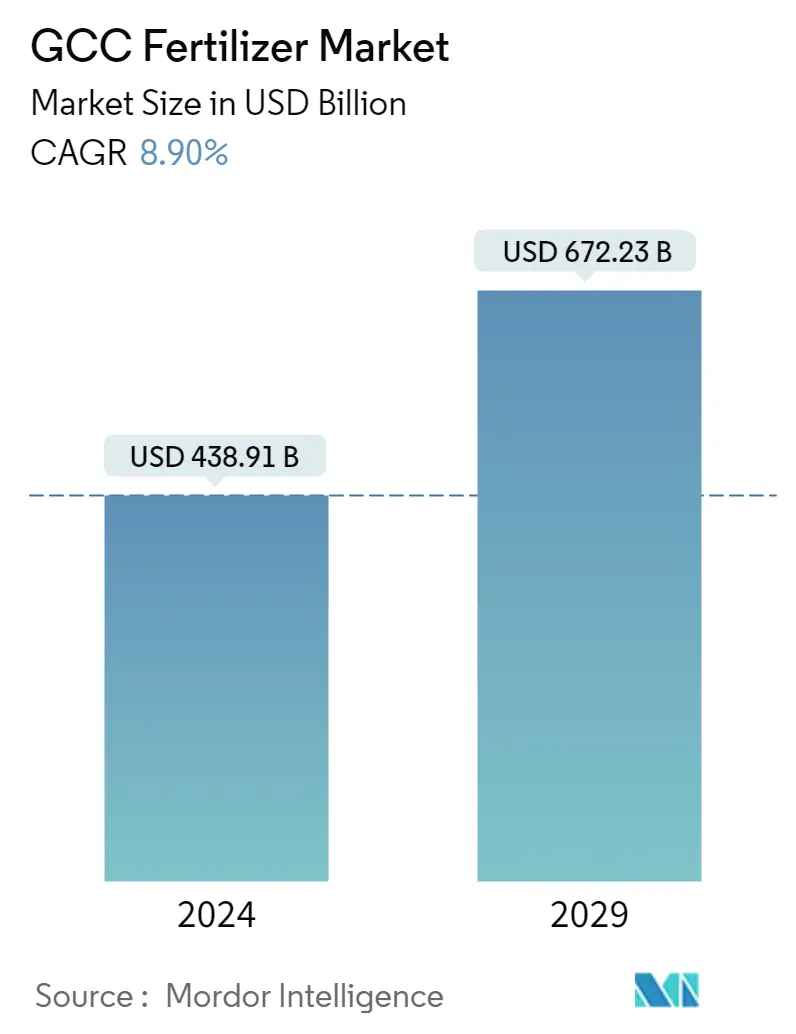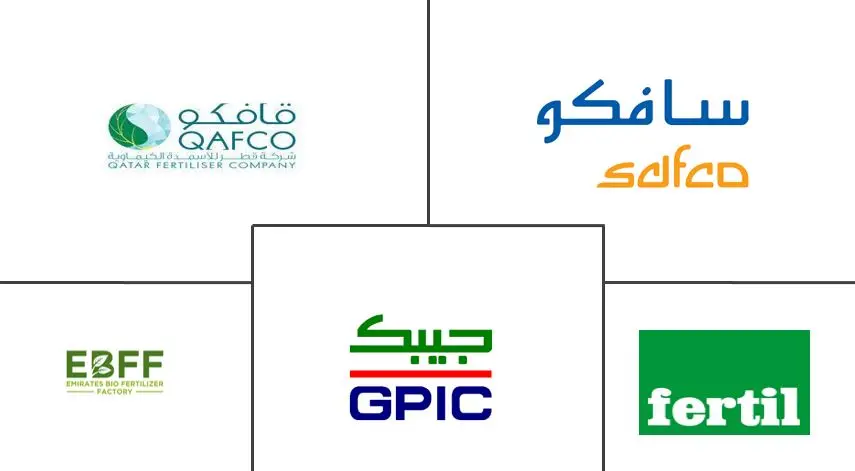Market Size of GCC Fertilizer Industry

| Study Period | 2019 - 2029 |
| Base Year For Estimation | 2023 |
| Forecast Data Period | 2024 - 2029 |
| Market Size (2024) | USD 438.91 Billion |
| Market Size (2029) | USD 672.23 Billion |
| CAGR (2024 - 2029) | 8.90 % |
Major Players
*Disclaimer: Major Players sorted in no particular order |
GCC Fertilizer Market Analysis
The GCC Fertilizer Market size is estimated at USD 438.91 billion in 2024, and is expected to reach USD 672.23 billion by 2029, growing at a CAGR of 8.90% during the forecast period (2024-2029).
The COVID-19 pandemic significantly impacted the GCC economy in 2020 due to social distancing measures, national lockdowns, and declining fertilizer prices. The chemical industry in the region is closely linked to economic activity, demand and supply headwinds, fluctuations in feedstock prices, and growth in end-user industries. It experienced the negative implications of the pandemic and the overall economic situation.
Increasing demand for food grains and growing awareness among the farming communities about the use of fertilizers to increase productivity are driving the fertilizer market. Increasing demand for fertilizers from other countries is driving production in the GCC countries. Saudi Arabia contributed 49% to the total fertilizer production of the GCC countries in 2019.
The nitrogenous fertilizer segment occupies a larger chunk of the market. However, the application of potassic fertilizers is growing rapidly, as it may enhance the plants' tolerance to abiotic stress, especially a lack of water, which may significantly reduce crop yields.
Fruit and vegetable production has been growing in the region as governments in the GCC countries are focused on achieving self-sufficiency. Furthermore, the COVID-19 pandemic has emphasized developing local food sources. According to the Food and Agriculture Organization, in 2020, primary fruit and vegetable production stood at 2,913.9 thousand metric ton and 1,052.1 thousand metric ton in Saudi Arabia.
GCC Fertilizer Industry Segmentation
The scope of the report also includes a comprehensive list of key market players, an analysis of their current strategic interests, and other key information. The GCC fertilizer market is segmented by product type and geography. The report offers market size and forecasts in terms of value (USD million) for the above segments.
| Product type | ||||||||
| ||||||||
| ||||||||
| ||||||||
| Secondary Nutrient Fertilizers | ||||||||
| Micronutrient Fertilizers |
| Application | |
| Grains and Cereals | |
| Pulses and Oil Seeds | |
| Fruits and Vegetables | |
| Commercial Crops | |
| Other Applications |
| Geography | |
| Saudi Arabia | |
| Qatar | |
| Oman | |
| United Arab Emirates | |
| Rest of GCC |
GCC Fertilizer Market Size Summary
The GCC fertilizer market is poised for significant growth, driven by increasing demand for food grains and heightened awareness among farming communities about the benefits of fertilizers in enhancing agricultural productivity. The region's fertilizer industry is closely linked to economic activities and is influenced by factors such as fluctuations in feedstock prices and growth in end-user industries. The COVID-19 pandemic initially posed challenges, impacting the economy and causing a decline in fertilizer prices. However, the subsequent focus on developing local food sources and achieving self-sufficiency in fruit and vegetable production has bolstered the market. Saudi Arabia, a major contributor to the region's fertilizer production, is enhancing its agricultural sector as part of Vision 2030, aiming to increase efficiency and develop rural areas.
The market is characterized by a fragmented landscape with key players such as Qatar Fertilizer Company, Saudi Arabian Fertilizer Company, and Gulf Petrochemical Industries Company leading the charge. The nitrogenous fertilizer segment dominates the market, although the application of potassic fertilizers is rapidly growing due to their potential in improving plant resilience to abiotic stress. The GCC region is also witnessing increased fertilizer exports, with India emerging as a significant market. Strategic investments and partnerships, such as those by SABIC Agri-Nutrients Company and JAS Global Industries, are further enhancing production capabilities and expanding market presence. The industry's positive growth trajectory is supported by increased production capacity and an evolving product portfolio, positioning the GCC fertilizer market for continued expansion.
GCC Fertilizer Market Size - Table of Contents
-
1. MARKET DYNAMICS
-
1.1 Market Overview
-
1.2 Market Drivers
-
1.3 Market Restraints
-
1.4 Porter's Five Forces Analysis
-
1.4.1 Threat of New Entrants
-
1.4.2 Bargaining Power of Buyers/Consumers
-
1.4.3 Bargaining Power of Suppliers
-
1.4.4 Threat of Substitute Products
-
1.4.5 Intensity of Competitive Rivalry
-
-
-
2. MARKET SEGMENTATION
-
2.1 Product type
-
2.1.1 Nitrogenous
-
2.1.1.1 Urea
-
2.1.1.2 Calcium Ammonium Nitrate (CAN)
-
2.1.1.3 Ammonium Nitrate
-
2.1.1.4 Ammonium Sulfate
-
2.1.1.5 Ammonia
-
2.1.1.6 Other Nitrogenous Fertilizers
-
-
2.1.2 Phosphatic
-
2.1.2.1 Mono-ammonium Phosphate (MAP)
-
2.1.2.2 Di-ammonium Phosphate (DAP)
-
2.1.2.3 Triple Superphosphate (TSP)
-
2.1.2.4 Other Phosphatic Fertilizers
-
-
2.1.3 Potassic
-
2.1.3.1 Muriate of Potash (MOP)
-
2.1.3.2 Sulfate of Potash (SOP)
-
-
2.1.4 Secondary Nutrient Fertilizers
-
2.1.5 Micronutrient Fertilizers
-
-
2.2 Application
-
2.2.1 Grains and Cereals
-
2.2.2 Pulses and Oil Seeds
-
2.2.3 Fruits and Vegetables
-
2.2.4 Commercial Crops
-
2.2.5 Other Applications
-
-
2.3 Geography
-
2.3.1 Saudi Arabia
-
2.3.2 Qatar
-
2.3.3 Oman
-
2.3.4 United Arab Emirates
-
2.3.5 Rest of GCC
-
-
GCC Fertilizer Market Size FAQs
How big is the GCC Fertilizer Market?
The GCC Fertilizer Market size is expected to reach USD 438.91 billion in 2024 and grow at a CAGR of 8.90% to reach USD 672.23 billion by 2029.
What is the current GCC Fertilizer Market size?
In 2024, the GCC Fertilizer Market size is expected to reach USD 438.91 billion.

